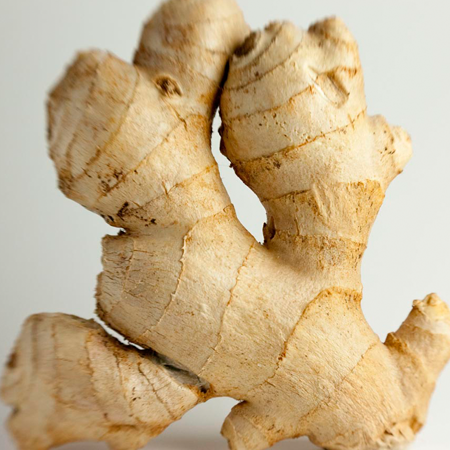

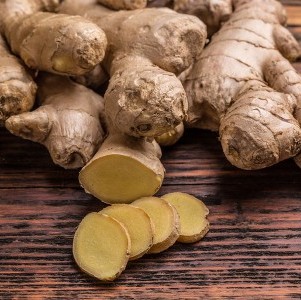
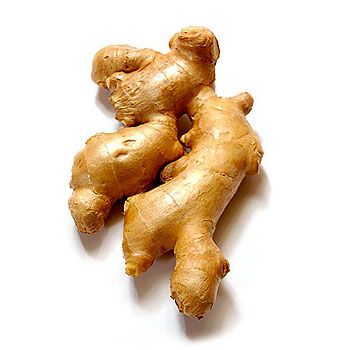
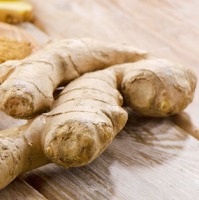
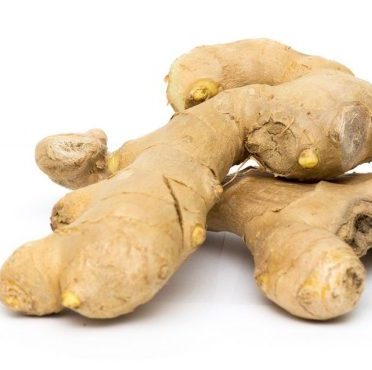
Botanical name Zingiber officinale Roscoe
Family Zingiberaceae
Source Root
Origin China
Processing Method Steam Distillation
Color/Consistency Yellow mobile liquid
Aromatic Summary / Note / Strength of Aroma Spicy ginger woody terpene
Blends With Lemon, Cedarwood, Lime, Eucalyptus, Frankincense, Geranium, Rosemary, Sandalwood, Patchouli, Myrtle, Bergamot, Rosewood, Neroli, Orange, and Ylang-Ylang.
Product Abstract
Ginger is commonly used as a spice, and it has its origins in India. The spice is very common in India (it is known as adrak in Hindi) and China and is now used all over the world. It forms an integral part of many Asian cuisines due to its digestive properties. It is especially helpful in digesting food items such as meat and poultry, and it is frequently added to recipes for cooking meat as it softens the meat considerably, making it easier to digest. Ginger root and ginger oil are also used as preservative and flavoring agents.
History
Ginger produces a hot, fragrant kitchen spice. Young ginger rhizomes are juicy and fleshy with a very mild taste. They are often pickled in vinegar or sherry as a snack or cooked as an ingredient in many dishes. They can be steeped in boiling water to make ginger herb tea, to which honey is often added; sliced orange or lemon fruit may be added. Ginger can be made into candy, or ginger wine, which has been made commercially since 1740.
Harvesting/Extraction Information
As the root is near the surface, you will often see small nobs at the soil line of your plant(s) that can be selectively cut for culinary use. Start harvesting about four months into the season and choose roots around the outer edge of the pot. At the end of the growing season when the leaves start to fade, uproot the plant and take a larger harvest if you need to.
Common Usage
Caution
Dilute before use; for external use only. May cause skin irritation in some individuals; a skin test is recommended prior to use. Contact with eyes should be avoided.
Key constituents
Zingiberene 38.1%
ar-Curcumene 17.1%
b-Sesquiphellandrene 7.2%
Camphene 4.7%
b-Bisabolene 5.2%
b-Phellandrene 2.5%
Borneol 2.2%
1,8-Cineole 2.1%
a-Pinene 1.3%
b-Elemene 1.2%
Quality Ginger oil is not commonly adulterated
Safety summary
Hazards None known.
Contraindications None known.
Regulatory guidelines
Has GRAS status.
Organ-specific effects
Adverse skin reactions Undiluted ginger oil was moderately irritating to rabbits, but was not irritating to mice; tested at 4% on 25 volunteers it was neither irritating nor sensitizing. Low-level phototoxic effects reported for ginger oil are not considered significant. Oral administration of ginger oil dose-dependently weakened the delayed hypersensitivity response, so any allergic reaction from the oil is likely to be minimal.
Systemic effects
Acute toxicity Ginger oil acute oral LD50 in rats >5 g/kg; acute dermal LD50 in rabbits >5 g/kg .
Subacute & subchronic toxicity In a 13 week oral toxicity study, ginger oil was administered to male and female rats at 100, 250 or 500 mg/kg/day. No adverse effects were seen, including mortality, decreased food consumption, changes in body weight or organ weights, hematological parameters, hepatic or renal function. No histopathological changes were noted in selected organs.
Antioxidant/pro-oxidant activity Ginger oil showed moderate antioxidant activity in lipid peroxidation tests, and high activity as a DPPH radical scavenge.
Carcinogenic/anticarcinogenic potential Ginger oil did not produce CA in CHL cells (Ishidate et al 1988). Ginger oil dose-dependently inhibited aflatoxin B1-induced adducts in calf thymus DNA, in the presence of rat liver microsomes Lam & Zheng reported that ginger oil induced glutathione S-transferase activity to more than 2.5 times control level in mouse tissues, and Banerjee et al that it significantly induced both glutathione S-transferase and aryl hydrocarbon hydroxylase in mouse liver, all of these being indicative of anticarcinogenic activity. Ginger oil was cytotoxic to human prostate and lung cancer cells with IC50 values of 0.08%, 0.11% respectively, but it was not cytotoxic to breast cancer cells. (þ)-Limonene, b-sesquiphellandrene, and b-elemene display anticarcinogenic activity.
Comments
In addition to China and India, major ginger oil producers include England and Jamaica. CO2 extracts are also available.